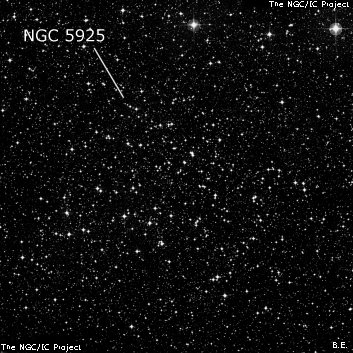
John Herschel discovered NGC 5925 = h3603 on 28 Jul 1826 and recorded "a most numerous and beautiful milky way group or cluster covering a space of 1.5 or 2 fields diameter (20' or 30') entirely composed of double and triple stars, and distinct groups of 4 or 5 nearly of a size (10th and 11th mag) on a black ground. Perhaps 100 or 150 stars in field." The next night he logged "a remarkable cluster, 20' diameter, R, very discrete, and composed of small groups of 2, 3, 4 stars, chiefly 11, 12 and 13th mag, sufficiently insulated from the rest of the pretty rich neighbourhood to be considered a cluster."
JH credited James Dunlop with the discovery (D 357), but Dunlop's position is a much better fit with NGC 5593 and an hour off in time from NGC 5925. Dreyer associated D 357 with both NGC 5593 and NGC 5925 in the NGC, so there was clearly some confusion.
400/500mm - 22" (6/28/06 - Hawaii): at 110x appears as a large, fairly rich cluster of ~150 stars mag 11 to 14 in a 25'x12' group (roughly rectangular) elongated SSW to NNE. Not concentrated and without any distinctive rich clumps, though many stars forming small subgroups. Situated in a rich region of the Milky Way and not distinguishable at moderate power but fairly detached using low power.
Notes by Steve Gottlieb